- Free Consultation: (631) 352-0050 Tap Here to Call Us
Appellate Court Issues Another Employee Friendly Decision

2024 has seen New York’s federal appellate court, the Second Circuit Court of Appeals, issue a string of employee friendly decisions. We have blogged about some of these decisions previously. On March 26, 2024, the Second Circuit decided an employment discrimination case which clarifies how trial courts should analyze discrimination cases. As we discuss in today’s Long Island employment law blog, the decision should result in more discrimination cases getting to trial.
In Bart v. Globus Corporation, the employer, Globus Corp., accused an employee, Elaine Bart, of falsifying food logs, maintained by the company to ensure health and safety. Globus fired Bart. Bart admitted that she violated the food log policy, but nonetheless, she alleged that the termination decision was made based on her gender. Accordingly, Bart sued Globus pursuant to, among other statutes, Title VII, the federal workplace anti-discrimination law.
To a layperson, this may seem like an open and shut case. The employer accused the employee of violating policy, the employee admitted to violating policy, and the employer fired the employee for violating the policy. How could this be unlawful discrimination then?
The answer is a complicated legal one. To put it simply, Congress has codified language in Title VII which allows for mixed-motive cases. This means that if an employer was motivated to fire an employee based on a discriminatory reason, the firing was unlawful, even if the employer also had legitimate, non-discriminatory reasons for the termination.
To understand mixed-motive cases, consider that you’re buying a house. You may like a particular house because it has three bathrooms, four bedrooms, a two-car garage, and granite counter tops in the kitchen. But, the house may also be in a great school district and this factor has motivated you to buy this particular house. All of these features of the house were part of the decision to buy the house, but you also ultimately decided to select this particular house, because of the school district. Thus, there are mixed reasons to buy the house – the number of bedrooms and bathrooms, granite, garage, — and the school district. The school district was a motivating factor to buy this particular house.
The same concept applies to discrimination cases. Title VII prohibits workplace discrimination based on characteristics such as sex, gender, national origin, race, and religion. An employer may decide to terminate an employee for many reasons, such as tardiness, poor performance, and/or insubordination. But, the if the employer also considered the employee’s race or religion when making the termination decision, it violated Title VII.
The difficulty comes in trying to find the unlawful reason. Rarely will an employer admit that it is discriminating against an employer. Over the years, courts have developed a test to analyze discrimination claims. Know as McDonnell-Douglas, this test first requires an employee to make a minimal showing of discrimination. Employees can do this with circumstantial evidence, such as showing that the employee has been treated differently than other employees outside of the protected class.
After meeting this burden, an employer can show that the employment decision was made for a legitimate, non-discriminatory reason. This is also a minimal showing. Then, the test moves to the “pretext” analysis, the heart of the issue in the Bart decision.
As observed by the Second Circuit, the pretext analysis has often been misunderstood and thus, misapplied, by trial courts. Some courts have required that an employee show that the employer’s “legitimate” reason for employment decision is false or merely a pre-text to cover up unlawful discrimination. As explained by the Bart decision, this application of McDonnell-Douglas is incorrect.
In Bart, the Second Circuit succinctly re-stated what an employee must show at the “pretext” stage of the analysis — plaintiffs need only show that the employer’s stated reason was not the real reason, even if the reason is true or factually accurate. In other words, an employee can show that the employer’s stated reason was not the whole reason, but rather that discrimination was “more likely than not” a factor in the decision, either in whole or in part. Notably, employees can make such a showing by relying on evidence it presented on its initial burden, and may not need to show any more.
Applying these principles to Bart, the Second Circuit noted that the employee produced evidence of gender-based animus towards her. A manager stated to her that he did not think women should be managers. Even though Bart admitted to violating company policy, it can also be true that she was terminated, in part, because of her gender. That possibility existed in the case because evidence showed that the decision-maker harbored a discriminatory animus, namely, the evidence of his gender based comments.
Discrimination cases are tricky because employers try to conceal their discriminatory motivations. Trained employment lawyers who understand the law can find the bits and pieces of evidence to establish an employment discrimination case.
If you have questions about proving an employment discrimination case, or about the Bart decision, contact a Long Island employment lawyer at (631) 352-0050. More information is available on our website at http://linycemploymentlaw.com.









